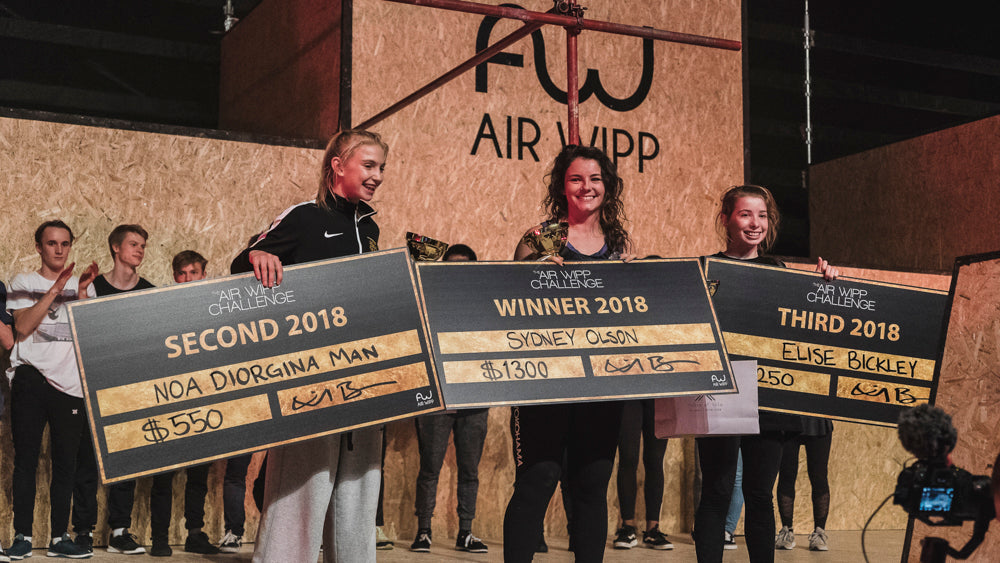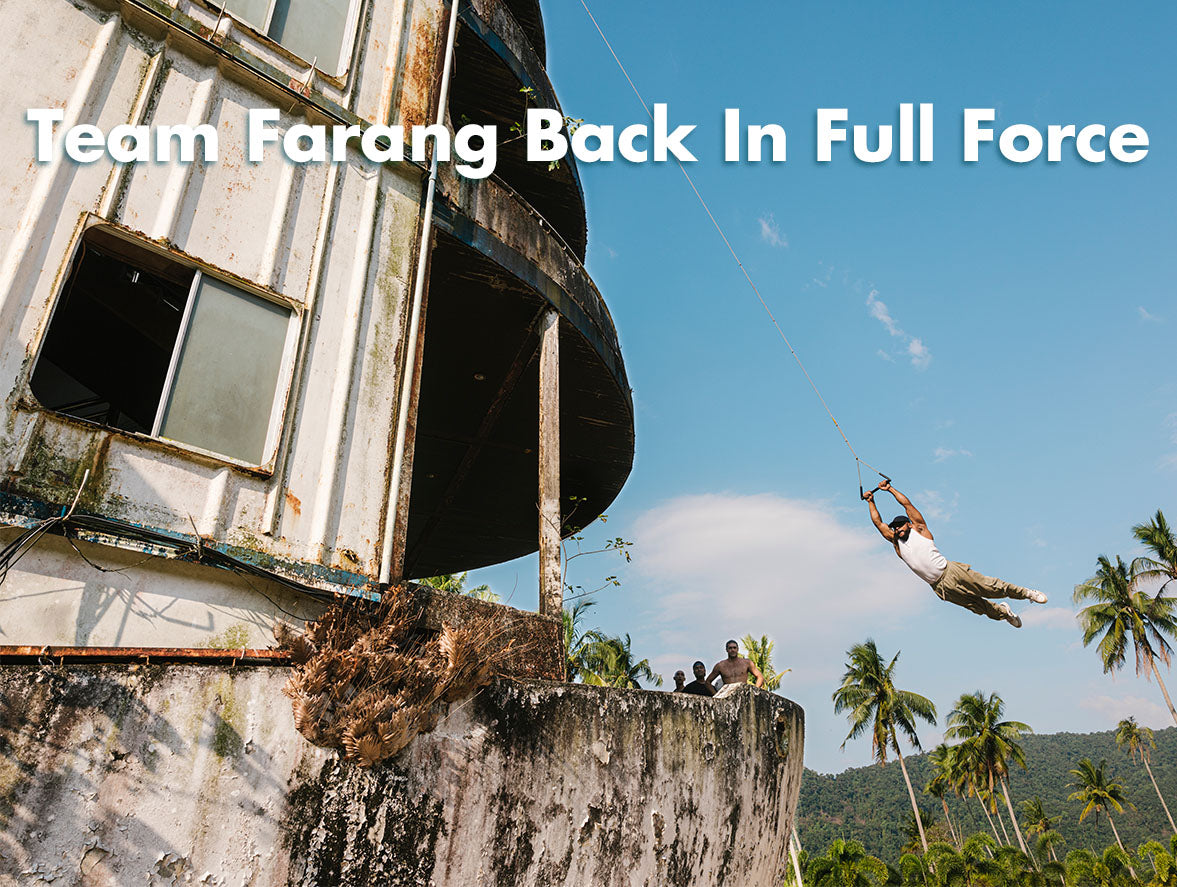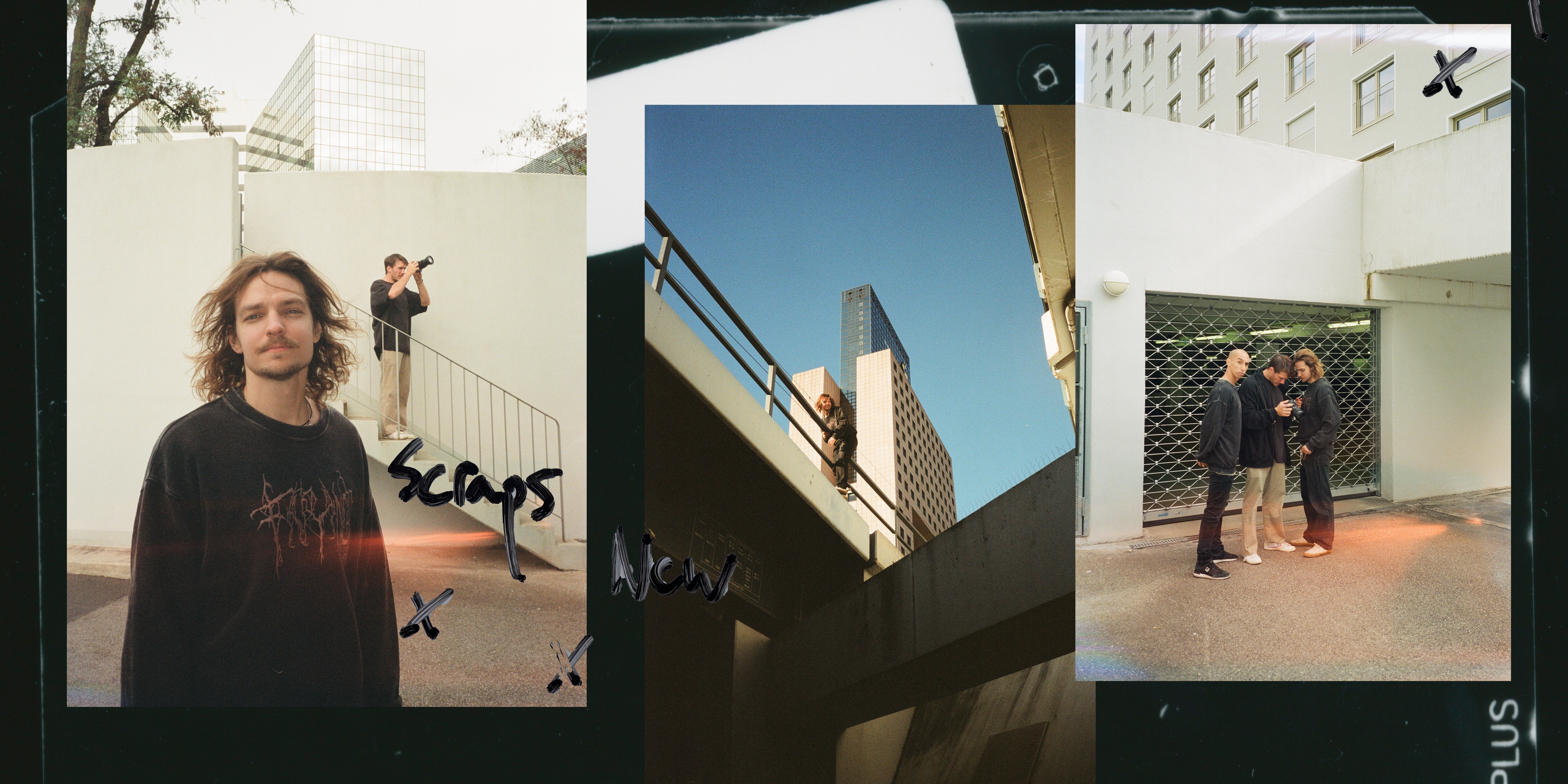Air Wipp Changing the Face of Women's Parkour

This year's Air Wipp competition seemed like a real step up as far as parkour events are concerned. As a spectator, everything felt pretty polished - with an incredible stage setup, complete with lights and pyrotechnic effects; a live stream commentated by Frosti Fresh and Benj Cave, finessed by an incredible camera crew of some of Parkour's biggest creative names; and even massive checks presented to the athletes, it seemed like nothing had been overlooked. However, what impressed me most about the event was Air Wipp’s effort when it came to the women’s competition, with steps being made to include women in the main event and to pay athletes equally. I spoke with Sydney Olsen, Noa Diorgina Man and Elise Bickley who made the podium, to find out how they found the event and how its changing their training.
When it comes to competitions, I find that the honorary ‘best female competitor’ title seems a like an embarrassing afterthought, however, Air Wipp is amongst the forerunners when it comes to creating a real space for women in competitive parkour. Noa explained, ‘I have only experienced two competitions with a women division, The Dutch Championship, and the Air Wipp Challenge. In the rest of the competitions I have been in, I competed against boys. I won’t be beaten as easily, but most boys are stronger, so it’s harder for me to compete against them.’

By allowing women to compete separately from men (like in virtually all other sports) women are given their own space to explore female movement without having to feel as though they have to compete against a group of people with completely different body types to them. Air Wipp gave women their own final in 2017. However this year they went a step further by bringing the women’s final onto the same day as the men's. Sydney told me, ‘I competed last year as well, but the events were on separate days. After watching the men’s event and seeing the value of it, I requested to Marcus and Filip that the women have finals on the same day as the men. They agreed, and it was absolutely amazing to be part of the main event.’

By bringing the male and female finals side by side, the female finalists were able to do their runs in front of a stadium of people (and be live-streamed to the rest of the world) rather than just performing in front of other athletes who were trying to qualify for the event and a few passers-by. This move is a hugely important one, not only because it legitimizes the women's comp but also pushes women to perform at a much higher level. Noa told me ‘When I put my feet at the set-up and watched the crowd cheer, the feeling was amazing. It energized me and made me incredibly happy; I think everybody could see that on my face.’

Air Wipp’s next move was another fantastic step in creating a nurturing environment for female athletes, by giving equal pay to the male and female athletes. And, with other established extreme sports like surfing, ski jumping and cliff diving being some of the last sports to award still not equal pay, its great to see, such a young sport like parkour, already showing that they value all their athletes equally.
These efforts from Air Wipp drew a great turnout of female athletes to the event, from all over the world. And, with higher stakes and a bigger platform to perform on, we saw the women pushing themselves harder to the podium. Noa told me ‘Airwipp got me inspired to train harder because the girls in that competition are really killing the stage.’ and Sydney agreed - ‘From me being one of the only girls, to suddenly competing against 15 other badass girls in our own division... It’s going to inspire more women to take the sport seriously and want to get involved in the competition.’.

And, don’t just have to take their word for it - it was pretty clear from their runs that Sydney, Noa, and Elise were pushing themselves to perform to a very high standard. With Sydney’s solid connections and powerful landings, Noa’s energy and unique style and, Elise pulling out two double flips in one run should hopefully inspire more women to push their abilities to new levels.

Competition is such a fantastic driving force when it comes to pushing people to improve their abilities and, by creating fiercer competition, we will hopefully see female parkour athletes pushing themselves to train harder for the next event. What Air Wipp achieved this year was not just setting a precedent for women in competitions, Air Wipps actions, and any other comps that follow suit, have the potential to affect the whole of women’s parkour for the better. If female athletes are encouraged to push the bar higher others will follow, and by women sharing their progressions on social media, the sport has the potential to blossom just like we’ve seen with women’s skateboarding recently.

It would be pretty crazy to talk about this event without mentioning that two of the women that podiumed are not, in fact, yet women at all. Noa who took second place is 13 years old, and Elise, who took third is 14. How is it that two of the best female parkour athletes in the world are still at school? A combination of things are in play - Access to gyms has become a huge driving force in the swift progressions of these girls, Noa having been coached at the Jump Freerun academy since she was seven years old and Elise having access to train at NovaCity. Access to safe, welcoming spaces like gyms, is especially important for young girls as training on the street can be particularly dangerous for young women and can cause anxiety about entering these spaces.

Noa and Elise both credited social media for their inspiration which is another large factor in forming talented female athletes. Women like Sydney Olsen, Lynn Jung and Pamela Forster killing it in competitions and posting their daily grind, inspires others to understand what their bodies are capable of and what it possible to push themselves to. Elise told me - ‘I always like to try tricks that I see on Instagram and put them in a line.’

The community is also starting to show a huge amount of support for female athletes, and you could see from the support of the crowd at Air Wipp that this is certainly true. Online, Noa told me she’s had male athletes stand up for her in the comments of her videos (big up Joe Scandrett). She also explained that in her local community it’s hard to find girls to train with but, ‘When [she] started [her] Instagram [she] was quickly approached by more and more girls from all over the world who do freerunning.’ And offline, women’s only training sessions have been popping up around the country, and events like Air Wipp, which make room for bigger groups of women to come and train together are helping to grow the parkour community in a more diverse and interesting way.
All Photos By Aleks Magnusson
About the Author: Fay Fillingham
Faye is a writer and fitness model from Brighton, UK. After becoming the youngest British woman to walk the Continental Divide Trail in 2014, she has become an advocate for women using extreme sports and outdoor pursuits as a tool to combat mental health problems. 




Comments
SlimSure New - March 15 2025
https://glot.io/snippets/h5i8335aow
https://glot.io/snippets/h5i82qg2fu
https://legacy.curseforge.com/minecraft/modpacks/slimsure-united-kingdom-denmark-is-this-worth-your
https://snippet.host/cnztpd
https://snippet.host/gtubas
https://ctxt.io/2/AAB4JYGOEg
https://ctxt.io/2/AAB4DbTVFg
https://ctxt.io/2/AAB4C-2dFw
https://paste2.org/Z5kCEccV
https://paste2.org/xby1DYHA
https://paste.cutelyst.org/EWc6X-DVQ
https://paste.cutelyst.org/ZEq2DIjPQ
https://www.mycompiler.io/view/IWojTRB1e9K
https://forum.obdeleven.com/thread/39870/slimsure-united-kingdom-denmark-worth
https://forums.phpfreaks.com/topic/327021-httpswwwfacebookcomslimsureuk2025/
https://forum.eastmans.com/threads/https-www-facebook-com-slimsure-denmark-free.41954/
https://community.wongcw.com/posts/1001880
https://forum.eastmans.com/threads/slimsure-united-kingdom-denmark-it-legit-and-safe-to-use.41953/
https://forums.serebii.net/threads/https-www-facebook-com-slimsure-uk-2025.771965/
https://glp1forum.com/threads/slimsure-united-kingdom-denmark-it-legit-and-safe-to-use.2816/
https://forum.eastmans.com/threads/https-www-facebook-com-slimsure-uk-2025.41952/
https://glp1forum.com/threads/https-github-com-pamelaespq-slimsure-uk-dk-official.2815/
https://www.squeegeeworld.com/threads/https-www-facebook-com-slimsure-uk-2025.19392/
https://lebanonhub.app/SlimSureNew
https://www.squeegeeworld.com/threads/slimsure-united-kingdom-denmark-is-this-worth-your-money.19393/
https://wocial.net/tema/https-www-facebook-com-slimsure-uk-2025.18033/
https://lebanonhub.app/blogs/175284/SlimSure-United-Kingdom-Denmark-Is-This-Worth-Your-Money
https://forum.thecodingcolosseum.com/topic/46564/https-www-facebook-com-slimsure-uk-2025
https://ideone.com/sRbZNK
https://www.mazafakas.com/transport/atvs-and-spare-parts/httpswww-facebook-comslimsure-uk-2025_i18742
https://wocial.net/tema/slimsure-united-kingdom-denmark-is-this-worth-your-money.18034/
https://forum.thecodingcolosseum.com/topic/46565/slimsure-united-kingdom-denmark-is-this-worth-your-money
https://www.africahunting.com/threads/https-www-facebook-com-slimsure-uk-2025.90846/
https://glp1forum.com/threads/slimsure-united-kingdom-denmark-it-legit-and-safe-to-use.2812/
https://www.sonicownersforum.com/forum/threads/slimsure-united-kingdom-denmark-it-legit-and-safe-to-use.62822/
https://glp1forum.com/threads/https-www-facebook-com-slimsure-uk-2025.2813/
https://www.sonicownersforum.com/forum/threads/slimsure-united-kingdom-denmark-is-this-worth-your-money.62823/
https://glp1forum.com/threads/https-suman-omeka-net.2814/
https://www.lawndork.com/forum/Posts/t90818-https—-knowt-com—note-bcb17b52-4ede-4fa9-b4b6-16b601ea2b1d-SlimSure-Denmark-100-works-This
https://www.lawndork.com/forum/Posts/t90817-https—-colab-research-google-com-drive-16Zf8xyJRqKLWRZbsotB0tZN5pF6ghLAL-usp
https://www.lawndork.com/forum/Posts/t90816-https—-www-bulbapp-com-u-slimsure-united-kingdom-denmark-is-this-worth-your-money
https://www.lawndork.com/forum/Posts/t90814-SlimSure—United-Kingdom-Denmark-Is-This-Worth-Your-Money
https://www.lawndork.com/forum/Posts/t90815-https—-www-facebook-com-SlimSure-UK-2025
https://forum.eurocompulsion.net/forum/welcome/introductions/216411-slimsure-united-kingdom-denmark-is-this-worth-your-money
https://forum.eurocompulsion.net/forum/welcome/introductions/216410-slimsure-united-kingdom-denmark-it-legit-and-safe-to-use
https://drsridharias.com/forums/discussion/history/slimsure-united-kingdom-denmarkit-legit-and-safe-to-use
https://drsridharias.com/forums/discussion/history/httpswwwfacebookcomslimsureuk2025
https://lamnongdan.com/agri/forum/main-forum/14504-slimsure-united-kingdom-denmark-is-this-worth-your-money
https://lamnongdan.com/agri/forum/main-forum/14503-slimsure-united-kingdom-denmark-it-legit-and-safe-to-use
https://payrchat.com/blogs/9872/httpswwwfacebookcomslimsureuk2025
https://crypto.jobs/talent/profile/https-www-facebook-com-slimsure-uk-2025
https://feedbackportal.microsoft.com/feedback/idea/2a63c87f-6d01-f011-a4de-6045bdb3947a
https://dotnetfiddle.net/2ytVLT
https://dotnetfiddle.net/4mB0x9
https://dotnetfiddle.net/cNaSqA
https://onlinegdb.com/b6jN2b67N
https://onlinegdb.com/sbc14oWh0m
https://onlinegdb.com/nL8rxK74E
https://onlinegdb.com/YbMoT0nlX
https://github.com/pamelaespq/SlimSure-United-Kingdom-Denmark
https://docsis.org/forums/docsis-chat/httpsgithubcompamelaespqslimsure-uk-dk-official
https://docsis.org/forums/docsis-chat/httpsknowtcomnote0980e1f6-f0ef-474f-8e00-705cf89aa367slimsure-denmark-official
https://docsis.org/forums/docsis-chat/httpsknowtcomnote03b6e73d-f31f-4834-9fba-6814bd28727cslimsure-united-kingdom
https://docsis.org/forums/docsis-chat/httpsknowtcomnoted5d12a98-c3d4-4d35-a6f7-18a2df8f7c04slimsure-united-kingdom
https://docsis.org/forums/docsis-chat/httpsknowtcomnote481d18c2-5b92-4c37-ab61-48c3c8d84154slimsure-united-kingdom
https://docsis.org/forums/docsis-chat/httpssumanomekanet
https://docsis.org/forums/docsis-chat/slimsureuk
https://docsis.org/forums/docsis-chat/slimsure-denmark
https://foro.ribbon.es/topic/63493/slimsure-united-kingdom-denmark-is-this-worth-your-money
https://foro.ribbon.es/topic/63492/https-www-facebook-com-slimsure-uk-2025
https://yhg.copiny.com/problem/details/id/316403
https://yhg.copiny.com/praise/details/id/42502
https://yhg.copiny.com/praise/details/id/42502
https://foro.ribbon.es/topic/63490/https-www-facebook-com-events-1324789412076032
https://glot.io/snippets/h5hrzenw46
https://glot.io/snippets/h5hryzvhyg
https://glot.io/snippets/h5hryhogk1
https://glot.io/snippets/h5hrxpxeug
https://ideone.com/NiL7YM
https://ideone.com/tzfyTp
https://forum.thecodingcolosseum.com/topic/46566/slimsure-united-kingdom-denmark-it-legit-and-safe-to-use
https://www.mazafakas.com/realestate/commercial-real-estate/httpswww-facebook-comslimsure-denmark-free_i18744
https://wocial.net/tema/slimsure-united-kingdom-denmark-it-legit-and-safe-to-use.18035/
https://www.mazafakas.com/transport/equipment-and-spareparts/httpswww-facebook-comevents1324789412076032_i18743
https://dogencyclopedia.net/thread/34058-https-www-facebook-com-slimsure-uk-2025/
https://dogencyclopedia.net/thread/34059-slimsure-united-kingdom-denmark-it-legit-and-safe-to-use/
https://forum.dasarforex.com/threads/https-www-facebook-com-slimsure-uk-2025.102371/
https://www.steadyhealth.com/topics/slimsure-united-kingdom-denmark-it-legit-and-safe-to-use
https://www.steadyhealth.com/topics/slimsure-united-kingdom-denmark-does-it-work
https://forum.dasarforex.com/threads/slimsure-united-kingdom-denmark-does-it-work.102375/
https://www.golfmk7.com/forums/index.php?threads/https-www-facebook-com-slimsure-uk-2025.468335/
https://www.golfmk7.com/forums/index.php?threads/slimsure-united-kingdom-denmark-does-it-work.468336/
https://www.mccentral.org/community/threads/https-www-facebook-com-slimsure-uk-2025.176439/
https://www.thegx.ca/forum/index.php?threads/https-www-facebook-com-slimsure-uk-2025.8028/
https://www.mccentral.org/community/threads/slimsure-united-kingdom-denmark-reviews-what-you-must-reading.176441/
https://store.yadea.com/community/xenforum/topic/164261/slimsure-united-kingdom-denmark-review-the-supplement-ingredient-benefits
https://store.yadea.com/community/xenforum/topic/164262/slimsure-united-kingdom-denmark-does-it-work
https://forum.nofap.com/index.php?threads/https-www-facebook-com-slimsure-uk-2025.370823/
https://www.thegx.ca/forum/index.php?threads/slimsure-united-kingdom-denmark-review-the-supplement-ingredient-benefits.8030/
https://forum.nofap.com/index.php?threads/slimsure-united-kingdom-denmark-%E2%80%93-is-this-worth-your-money.370826/
https://sikatpinoy.net/threads/https-www-facebook-com-slimsure-uk-2025.3491/
https://sikatpinoy.net/threads/slimsure-united-kingdom-denmark-is-this-worth-your-money.3492/
https://www.runelister.com/forum/topic/https-www-facebook-com-slimsure-uk-2025/#postid-31868
https://www.runelister.com/forum/topic/slimsure-united-kingdom-denmarkreview-the-supplement-ingredient-benefits/#postid-31869
https://www.setlist.fm/forum/setlistfm/website-support/httpswwwfacebookcomslimsureuk2025httpswwwfacebookcomslimsureuk2025-bd77d96
https://chennaiclassic.com/listing/https-www-facebook-com-slimsure-uk-2025/
https://chennaiclassic.com/listing/slimsure-united-kingdom-denmark-it-legit-and-safe-to-use/
https://wegug.in/SlimSureNew
https://wegug.in/blogs/48284/https-www-facebook-com-SlimSure-UK-2025
https://wegug.in/blogs/48286/SlimSure-United-Kingdom-Denmark-It-Legit-and-Safe-To-Use
https://sqlgulf.org/forums/topic/slimsure-united-kingdom-denmark-it-legit-and-safe-to-use/#postid-12877
https://sqlgulf.org/forums/topic/https-www-facebook-com-slimsure-uk-2025/#postid-12878
https://afterpad.com/forums/viewtopic.php?pid=246983#p246983
https://afterpad.com/forums/viewtopic.php?pid=246989#p246989
https://www.eventogo.com/?ptype=success&pid=325949
https://padeltennisforum.com/threads/https-www-facebook-com-slimsure-uk-2025.1186/
https://padeltennisforum.com/threads/slimsure-united-kingdom-denmark-does-it-work.1187/
https://www.styleforum.net/threads/slimsure-united-kingdom-denmark-it-legit-and-safe-to-use.795687/
https://www.styleforum.net/threads/https-www-facebook-com-slimsure-uk-2025.795689/
https://en.smath.com/forum/yaf_postsm86670_SlimSure—United-Kingdom-Denmark-Is-This-Worth-Your-Money.aspx#post86670
https://www.onlinegdb.com/0ayVYB9Vf
https://ideone.com/6RXdTp
https://chennaiclassic.com/listing/https-www-facebook-com-slimsure-uk-2025-2/
https://chennaiclassic.com/listing/slimsure-united-kingdom-denmarkit-legit-and-safe-to-use/
https://forums.minecraft-infected.com/threads/https-www-facebook-com-slimsure-uk-2025.22938/
https://forums.minecraft-infected.com/threads/slimsure-united-kingdom-denmark-it-legit-and-safe-to-use.22939/
https://thehytaleforum.net/threads/https-www-facebook-com-slimsure-uk-2025.1918/
https://afterpad.com/forums/viewtopic.php?pid=248942#p248942
https://oxiinstruments.com/forum/d/2410-httpswwwfacebookcomslimsureuk2025
https://oxiinstruments.com/forum/d/2411-slimsure-united-kingdom-denmarkis-this-worth-your-money
https://lyfepal.com/posts/474953
https://lyfepal.com/pages/SlimSureNew
https://chobaolam.vn/threads/https-www-facebook-com-slimsure-uk-2025.619030/
https://chobaolam.vn/threads/slimsure-united-kingdom-denmark-is-this-worth-your-money.619032/
https://forumforex.id/forum/forumforexid/rule-informasi/141032-slimsure-united-kingdom-denmark-is-this-worth-your-money
https://forumforex.id/forum/forumforexid/rule-informasi/141033-slimsure-united-kingdom-denmark-it-legit-and-safe-to-use
https://raovat49.com/s/slimsure-united-kingdomdenmarkis-this-worth-your-money-5885337
https://www.chess.com/forum/view/general/https-www-facebook-com-slimsure-uk-2025
https://forums.phpfreaks.com/topic/327022-slimsure-united-kingdom-denmarkis-this-worth-your-money/
https://ideone.com/Nc2yy1
https://www.mycompiler.io/view/7HMoTHvLRob
https://www.mycompiler.io/view/IWojTRB1e9K
https://paiza.io/projects/_dmqdgPgmjGdNXZLUuy-Ug
https://paiza.io/projects/1HmFFQEtBx9R1rhg-QU8rg
SlimSure New - March 15 2025
SlimSure: An In-Depth Look at the Natural Weight Loss Supplement
Navigating the vast array of weight loss supplements can be overwhelming, but SlimSure has emerged as a natural and effective option for those looking to manage their weight in a healthy way. Formulated with scientifically supported ingredients, SlimSure not only promotes weight loss but also enhances overall well-being. This article takes a closer look at what SlimSure is, how it works, and what users can expect from this supplement.
https://www.facebook.com/SlimSure.UK.2025/
https://www.facebook.com/groups/slimsureunitedkingdomofficial
https://www.facebook.com/events/1324789412076032/
https://www.facebook.com/SlimSure.Denmark.Free/
https://knowt.com//note/481d18c2-5b92-4c37-ab61-48c3c8d84154/SlimSure-United-Kingdom—Is-This-Worth-
https://knowt.com//note/d5d12a98-c3d4-4d35-a6f7-18a2df8f7c04/SlimSure-United-Kingdom-Reviews-What-Yo
https://knowt.com//note/03b6e73d-f31f-4834-9fba-6814bd28727c/SlimSure-United-Kingdom-Review-the-Supp
https://knowt.com//note/0980e1f6-f0ef-474f-8e00-705cf89aa367/SlimSure-Denmark-Official-Website-Buy-No
https://knowt.com//note/0b33bd83-6eb7-4b00-b5f4-d5f0417b0055/SlimSure-Denmark-Special-Offer-2025
https://knowt.com//note/bcb17b52-4ede-4fa9-b4b6-16b601ea2b1d/SlimSure-Denmark-100-works-This
https://suman.omeka.net/
https://colab.research.google.com/drive/16Zf8xyJRqKLWRZbsotB0tZN5pF6ghLAL?usp
https://colab.research.google.com/drive/1LNqKwLf4bcmUr2wQzNsPA50fxlj625Mt?usp
https://colab.research.google.com/drive/1mTg2tdQPkOR3QOhKesf9wvVCa5I2_hvg?usp
https://colab.research.google.com/drive/1kP-k2Au4unw68rhYlUQH3H9OzK1r5ISp?usp
https://nas.io/slimsureofficial/challenges/slimsure-united-kingdomdenmark-review-the-supplement-ingredient-benefits
https://nas.io/slimsureofficial/challenges/slimsure-united-kingdomdenmark-is-this-worth-your-money
https://nas.io/slimsureofficial/challenges/slimsure-united-kingdomdenmark-reviews-what-you-must-reading
https://slimsure-uk-dk.godaddysites.com/
https://slimsure-united-kingdom-denmar.godaddysites.com/
https://slimsure-uk-dk.mywebselfsite.net/
https://github.com/pamelaespq/SlimSure-United-Kingdom-Denmark
https://github.com/pamelaespq/SlimSure-UK-DK-Official
https://github.com/pamelaespq/SlimSure-United-Kingdom-Denmark-It-Legit-and-Safe-To-Use
https://www.bulbapp.com/u/slimsure-united-kingdom-denmark-is-this-worth-your-money
https://forums.ngames.com/forum/league-of-angels/community-ab/general-discussion-ab/186961-slimsure-united-kingdom-denmark-%E2%80%93-is-this-worth-your-money
https://forums.ngames.com/forum/league-of-angels/community-ab/general-discussion-ab/186966-slimsure-united-kingdom-denmark-review-the-supplement-ingredient-benefits
https://www.italki.com/en/post/rOYOh3oBlafJYdOdulNuau
https://slimsureofficial.blogspot.com/2025/03/slimsure-denmark-is-this-worth-your.html
https://slimsureofficial.blogspot.com/2025/03/slimsure-united-kingdom-denmark-review.html
https://slimsureofficial.blogspot.com/2025/03/slimsure-denmark-does-it-work.html
https://slimsureofficial.blogspot.com/2025/03/slimsure-united-kingdom-it-legit-and.html
https://www.facebook.com/GlycoBalance.Australia.NewZealand.Official/
https://colab.research.google.com/drive/1IxTCTkfhxBQfKZ6hY8AEVngSrDrdRQSR
https://colab.research.google.com/drive/1vWAJoP2jtZpK_XfW6-CZCBDY79BzqlKM
https://colab.research.google.com/drive/1KxNXj_5IqtPNDCkv-LletwODIv55HsGx
https://github.com/OfficialGlycoBalance/GlycoBalance.Australia.NewZealand.Official
https://github.com/OfficialGlycoBalance/Glyco-Balance-Reviews-Australia-New-Zealand-2025-NEW-Formula
https://github.com/OfficialGlycoBalance/Glyco-Balance-Official-Website-Au-Nz
https://www.provenexpert.com/en-us/glycobalanceaustralia-newzealand-official/
https://glyco-balance-australia-new-zealand-2025.mywebselfsite.net/
https://github.com/OfficialSpiderSenseMaleEnhancement/Spider-Sense-Male-Enhancement
https://github.com/OfficialSpiderSenseMaleEnhancement/Spider-Sense-Male-Enhancement-Official-Website-2025
https://github.com/OfficialSpiderSenseMaleEnhancement/Spider-Sense-Male-Enhancement-Does-It-Improve-Sexual-Performance-
Trumph Donalds - March 11 2025
https://balancenz.omeka.net/
https://balancenz.omeka.net/glyco-balance-new-zealand
http://balanceau.omeka.net/
https://balanceau.omeka.net/glyco-balance-australia
https://lycocare.omeka.net/
https://lycocare.omeka.net/glyco-care
index - October 20 2024
url url
url url
url url
url url
url url
url url
url url
url url
url url
url url
url url
url url
url url
url url
url url
url url
url url
url url
url url
url url
url url
url url
url url
url url
url url
url url
url url
url url
url url
url url
url url
url url
url url
url url
url url
url url
url url
url url
url url
url url
url url
url url
url url
url url
url url
url url
url url
url url
url url
url url
url url
url url
url url
url url
url url
url url
url url
url url
url url
url url
url url
url url
شركة نقل عفش بجدة - June 07 2024
https://emc-mee.com/blog.html شركات نقل العفش
اهم شركات كشف تسربات المياه بالدمام كذلك معرض اهم شركة مكافحة حشرات بالدمام والخبر والجبيل والخبر والاحساء والقطيف كذكل شركة تنظيف خزانات بجدة وتنظيف بجدة ومكافحة الحشرات بالخبر وكشف تسربات المياه بالجبيل والقطيف والخبر والدمام
https://emc-mee.com/cleaning-company-yanbu.html شركة تنظيف بينبع
https://emc-mee.com/blog.html شركة نقل عفش
اهم شركات مكافحة حشرات بالخبر كذلك معرض اهم شركة مكافحة حشرات بالدمام والخبر والجبيل والخبر والاحساء والقطيف كذلك شركة رش حشرات بالدمام ومكافحة الحشرات بالخبر
https://emc-mee.com/anti-insects-company-dammam.html شركة مكافحة حشرات بالدمام
شركة تنظيف خزانات بجدة الجوهرة من افضل شركات تنظيف الخزانات بجدة حيث ان تنظيف خزانات بجدة يحتاج الى مهارة فى كيفية غسيل وتنظيف الخزانات الكبيرة والصغيرة بجدة على ايدى متخصصين فى تنظيف الخزانات بجدة
https://emc-mee.com/tanks-cleaning-company-jeddah.html شركة تنظيف خزانات بجدة
https://emc-mee.com/water-leaks-detection-isolate-company-dammam.html شركة كشف تسربات المياه بالدمام
https://emc-mee.com/ شركة الفا لنقل عفش واثاث
https://emc-mee.com/transfer-furniture-jeddah.html شركة نقل عفش بجدة
https://emc-mee.com/transfer-furniture-almadina-almonawara.html شركة نقل عفش بالمدينة المنورة
https://emc-mee.com/movers-in-riyadh-company.html شركة نقل اثاث بالرياض
https://emc-mee.com/transfer-furniture-dammam.html شركة نقل عفش بالدمام
https://emc-mee.com/transfer-furniture-taif.html شركة نقل عفش بالطائف
https://emc-mee.com/transfer-furniture-mecca.html شركة نقل عفش بمكة
https://emc-mee.com/transfer-furniture-yanbu.html شركة نقل عفش بينبع
https://emc-mee.com/transfer-furniture-alkharj.html شركة نقل عفش بالخرج
https://emc-mee.com/transfer-furniture-buraydah.html شركة نقل عفش ببريدة
https://emc-mee.com/transfer-furniture-khamis-mushait.html شركة نقل عفش بخميس مشيط
https://emc-mee.com/transfer-furniture-qassim.html شركة نقل عفش بالقصيم
https://emc-mee.com/transfer-furniture-tabuk.html شركة نقل عفش بتبوك
https://emc-mee.com/transfer-furniture-abha.html شركة نقل عفش بابها
https://emc-mee.com/transfer-furniture-najran.html شركة نقل عفش بنجران
https://emc-mee.com/transfer-furniture-hail.html شركة نقل عفش بحائل
https://emc-mee.com/transfer-furniture-dhahran.html شركة نقل عفش بالظهران
https://emc-mee.com/transfer-furniture-kuwait.html شركة نقل عفش بالكويت
https://emc-mee.com/price-transfer-furniture-in-khamis-mushit.html اسعار شركات نقل عفش بخميس مشيط
https://emc-mee.com/numbers-company-transfer-furniture-in-khamis-mushit.html ارقام شركات نقل عفش بخميس مشيط
https://emc-mee.com/new-company-transfer-furniture-in-khamis-mushit.html شركة نقل عفش بخميس مشيط جديدة
https://emc-mee.com/transfer-furniture-from-khamis-to-riyadh.html شركة نقل عفش من خميس مشيط الي الرياض
https://emc-mee.com/transfer-furniture-from-khamis-mushait-to-mecca.html شركة نقل عفش من خميس مشيط الي مكة
https://emc-mee.com/transfer-furniture-from-khamis-mushait-to-jeddah.html شركة نقل عفش من خميس مشيط الي جدة
https://emc-mee.com/transfer-furniture-from-khamis-mushait-to-medina.html شركة نقل عفش من خميس مشيط الي المدينة المنورة
https://emc-mee.com/best-10-company-transfer-furniture-khamis-mushait.html افضل 10 شركات نقل عفش بخميس مشيط
https://emc-mee.com/%D8%B4%D8%B1%D9%83%D9%87-%D9%86%D9%82%D9%84-%D8%B9%D9%81%D8%B4-%D8%A8%D8%AC%D8%AF%D9%87.html
https://emc-mee.com/%D8%B4%D8%B1%D9%83%D8%A9-%D9%86%D9%82%D9%84-%D8%A7%D8%AB%D8%A7%D8%AB-%D8%A8%D8%AC%D8%AF%D9%87.html
نقل عفش شمال الرياض - June 07 2024
https://companymovers9.wordpress.com/
https://newmoverdotblog.wordpress.com/
https://qwasdew.wordpress.com/
https://gigisaad.wordpress.com/
اهم شركات نقل العفش بمكة - June 07 2024
https://fullservicelavoro.jimdosite.com/
http://treeads.nation2.com/
https://jumperads.yolasite.com/
http://jumperads.nation2.com/
http://transferefurniture.hatenablog.com
https://atar-almadinah.weebly.com/
https://allmoversinriyadh.wordpress.com/
https://allmoversinriyadh.wordpress.com/2022/04/09/%d8%b4%d8%b1%d9%83%d8%a9-%d8%aa%d9%86%d8%b8%d9%8a%d9%81-%d8%a8%d8%a7%d9%84%d8%b1%d9%8a%d8%a7%d8%b6-%d9%85%d8%ac%d8%b1%d8%a8%d8%a9/
https://allmoversinriyadh.wordpress.com/2022/04/07/%d8%a7%d9%81%d8%b6%d9%84-%d8%b4%d8%b1%d9%83%d8%a9-%d8%aa%d9%86%d8%b8%d9%8a%d9%81-%d8%a8%d8%a7%d9%84%d8%b1%d9%8a%d8%a7%d8%b6/
https://allmoversinriyadh.wordpress.com/2022/05/13/%d8%b4%d8%b1%d9%83%d8%a9-%d9%86%d9%82%d9%84-%d8%b9%d9%81%d8%b4-%d9%88%d8%ba%d8%b1%d9%81-%d8%a7%d9%84%d9%86%d9%88%d9%85-%d8%a8%d8%a7%d9%84%d8%b1%d9%8a%d8%a7%d8%b6/
https://companymoversinjeddah.wordpress.com/
https://moversfurniture2018.wordpress.com/2018/12/30/%D8%A7%D9%87%D9%85-%D9%85%D9%83%D8%A7%D8%AA%D8%A8-%D9%88%D9%85%D8%A4%D8%B3%D8%B3%D8%A7%D8%AA-%D8%B4%D8%B1%D9%83%D8%A7%D8%AA-%D9%86%D9%82%D9%84-%D8%B9%D9%81%D8%B4-%D8%A8%D8%AC%D8%A7%D8%B2%D8%A7%D9%86/
https://moversriyadhcom.wordpress.com/
https://moversmedina.wordpress.com/
https://moversfurniture2018.wordpress.com/
https://moversmecca.wordpress.com/
https://khairyayman74.wordpress.com/
https://companymoversmecca.home.blog/
https://companymoverstaif.home.blog/
https://companymoverskhamismushit.home.blog/
https://whitear.home.blog/
https://companyhouseservice.wordpress.com/
http://bestmoversfurniture.wordpress.com/
https://companymoversjeddah.wordpress.com/
https://companycleaning307819260.wordpress.com/
https://companymoversriydah.wordpress.com/
https://ataralmadinah662300791.wordpress.com/
https://groups.google.com/g/moversfurniture/c/wwQFSNvgyAI
https://groups.google.com/g/moversfurniture/c/4L1oHETS4mQ
https://nowewyrazy.uw.edu.pl/profil/khairyayman
https://companyhouseservice.wordpress.com/2022/08/06/%d8%a7%d9%81%d8%b6%d9%84-%d8%b4%d8%b1%d9%83%d8%a9-%d8%aa%d9%86%d8%b8%d9%8a%d9%81-%d8%a8%d8%a7%d9%84%d8%b1%d9%8a%d8%a7%d8%b6/
شركة ريلاكس لنقل العفش والاثاث - June 07 2024
http://fullservicelavoro.com/ شركة ريلاكس لنقل العفش والاثاث
http://fullservicelavoro.com/2019/01/07/transfer-movers-taif-furniture/ شركة نقل عفش بالطائف
http://fullservicelavoro.com/2019/01/08/transfer-movers-riyadh-furniture/ شركة نقل عفش بالرياض
http://fullservicelavoro.com/2019/01/08/transfer-movers-jeddah-furniture/ شركة نقل عفش بجدة
http://fullservicelavoro.com/2019/01/01/transfer-and-movers-furniture-mecca/ شركة نقل عفش بمكة
http://fullservicelavoro.com/2019/01/07/transfer-movers-madina-furniture/ شركة نقل عفش بالمدينة المنورة
http://fullservicelavoro.com/2019/01/07/transfer-movers-khamis-mushait-furniture/ شركة نقل عفش بخميس مشيط
http://fullservicelavoro.com/2019/01/09/transfer-movers-abha-furniture/ شركة نقل اثاث بابها
http://fullservicelavoro.com/2019/01/07/transfer-movers-najran-furniture/ شركة نقل عفش بنجران
http://fullservicelavoro.com/2019/01/16/transfer-movers-hail-furniture/ ِشركة نقل عفش بحائل
http://fullservicelavoro.com/2019/01/16/transfer-movers-qassim-furniture/ شركة نقل عفش بالقصيم
http://fullservicelavoro.com/2019/02/02/transfer-movers-furniture-in-bahaa/ شركة نقل عفش بالباحة
http://fullservicelavoro.com/2019/01/13/transfer-movers-yanbu-furniture/ شركة نقل عفش بينبع
http://fullservicelavoro.com/2019/01/18/%d8%af%d9%8a%d9%86%d8%a7-%d9%86%d9%82%d9%84-%d8%b9%d9%81%d8%b4-%d8%a8%d8%a7%d8%a8%d9%87%d8%a7/ دينا نقل عفش بابها
http://fullservicelavoro.com/2019/01/13/%D9%86%D9%82%D9%84-%D8%A7%D9%84%D8%A7%D8%AB%D8%A7%D8%AB-%D8%A8%D8%A7%D9%84%D9%85%D8%AF%D9%8A%D9%86%D8%A9-%D8%A7%D9%84%D9%85%D9%86%D9%88%D8%B1%D8%A9-%D8%A7%D9%87%D9%85-%D8%B4%D8%B1%D9%83%D8%A7%D8%AA/ نقل الاثاث بالمدينة المنورة
http://fullservicelavoro.com/2019/01/12/%D8%A7%D8%B1%D8%AE%D8%B5-%D8%B4%D8%B1%D9%83%D8%A9-%D9%86%D9%82%D9%84-%D8%B9%D9%81%D8%B4-%D8%A8%D9%85%D9%83%D8%A9/ ارخص شركة نقل عفش بمكة
http://fullservicelavoro.com/2019/01/07/transfer-movers-elkharj-furniture/ شركة نقل عفش بالخرج
http://fullservicelavoro.com/2019/01/07/transfer-movers-baqaa-furniture/ شركة نقل عفش بالبقعاء
http://fullservicelavoro.com/2019/02/05/transfer-furniture-in-jazan/ شركة نقل عفش بجازان
اهم شركات نقل العفش بمكة - June 07 2024
https://sites.google.com/view/movers-riyadh/
https://sites.google.com/view/movers-riyadh/movers-mecca
https://sites.google.com/view/movers-riyadh/home
https://sites.google.com/view/movers-riyadh/movers-jedaah-elhamdniah
https://sites.google.com/view/movers-riyadh/movers-yanbu
https://sites.google.com/view/movers-riyadh/movers-najran
https://sites.google.com/view/movers-riyadh/movers-Jizan
https://sites.google.com/view/movers-riyadh/jazan
https://sites.google.com/view/movers-riyadh/taif
https://sites.google.com/view/movers-riyadh/moversjeddah
https://sites.google.com/view/movers-riyadh/movers-abha
https://sites.google.com/view/movers-riyadh/movers-elahsa
https://sites.google.com/view/movers-riyadh/movers-elkhobar
https://sites.google.com/view/movers-riyadh/movers-elkharj
https://sites.google.com/view/movers-riyadh/movers-elmadina-elmnowara
https://sites.google.com/view/movers-riyadh/movers-eljubail
https://sites.google.com/view/movers-riyadh/movers-elqassim
https://sites.google.com/view/movers-riyadh/movers-hafrelbatin
https://sites.google.com/view/movers-riyadh/movers-elbaha
https://sites.google.com/view/movers-riyadh/movers-jeddah
https://sites.google.com/view/movers-riyadh/movers-dammam
https://sites.google.com/view/movers-riyadh/movers-taif
https://sites.google.com/view/movers-riyadh/movers-burydah
https://sites.google.com/view/movers-riyadh/movers-tabuk
https://sites.google.com/view/movers-riyadh/movers-hail
https://sites.google.com/view/movers-riyadh/movers-khamis-mushait
https://sites.google.com/view/movers-riyadh/movers-rabigh
https://sites.google.com/view/movers-riyadh/madina
https://sites.google.com/view/movers-riyadh/mecca
https://sites.google.com/view/movers-riyadh/dammam
https://sites.google.com/view/movers-riyadh/jeddah
https://sites.google.com/view/movers-riyadh/ahsa
https://sites.google.com/view/movers-riyadh/cleaning-mecca
شركة تنظيف فلل بحائل - June 07 2024
شركة مكافحة حشرات بحائل وكذلك شركة كشف تسربات المياه بحائل وتنظيف خزانات وتنظيف الموكيت والسجاد والكنب والشقق والمنازل بحائل وتنظيف الخزانات بحائل وتنظيف المساجد بحائل شركة تنظيف بحائل تنظيف المسابح بحائل
https://jumperads.com/hail/anti-insects-company-hail.html شركة مكافحة حشرات بحائل
https://jumperads.com/hail/water-leaks-detection-company-hail.html شركة كشف تسربات بحائل
https://jumperads.com/hail/hail-company-surfaces.html شركة عزل اسطح بحائل
https://jumperads.com/hail/hail-company-sewage.html شركة تسليك مجاري بحائل
https://jumperads.com/hail/hail-cleaning-company-sofa.html شركة تنظيف كنب بحائل
https://jumperads.com/hail/hail-cleaning-company-mosques.html شركة تنظيف مساجد بحائل
https://jumperads.com/hail/hail-cleaning-company-Carpet.html شركة تنظيف سجاد بحائل
https://jumperads.com/hail/hail-cleaning-company-tanks.html شركة تنظيف خزانات بحائل
https://jumperads.com/hail/hail-cleaning-company-swimming-bath.html شركة تنظيف وصيانة مسابح بحائل
https://jumperads.com/hail/hail-cleaning-company-Furniture.html شركة تنظيف الاثاث بحائل
https://jumperads.com/hail/hail-cleaning-company-home.html شركة تنظيف شقق بحائل
https://jumperads.com/hail/hail-cleaning-company-Carpets.html شركة تنظيف موكيت بحائل
https://jumperads.com/hail/hail-cleaning-company.html شركة تنظيف مجالس بحائل
https://jumperads.com/hail/hail-cleaning-company-house.html شركة تنظيف منازل بحائل
https://jumperads.com/hail/hail-cleaning-company-curtains.html شركة تنظيف ستائر بحائل
https://jumperads.com/hail/hail-cleaning-company-Villas.html شركة تنظيف فلل بحائل
https://jumperads.com/hail/hail-company-tile.html شركة جلي بلاط بحائل
defrgtyhjuiklo;p - March 26 2024
https://www.myminifactory.com/stories/how-to-watch-godzilla-x-kong-the-new-empire-2024-online-for-free-on-123movies-660206e808174
https://pastebin.com/F0wFcQGh
https://jsbin.com/rorolosupo/edit?html,output
https://tempaste.com/eMdP6Xdq2GY
https://www.scoop.it/topic/zxcvbnmj-kl/?rescoopPostId=4151876365
https://www.bankier.pl/forum/wiadomosc-zapisana?post_id=65630423&obs=&emal=&st=1&thread_id=
https://paste.myst.rs/fjy6pm7g
https://sco.lt/5WDjoe
https://jsfiddle.net/b529Lqru/
https://paste.ee/p/kUCJ3
https://www.myminifactory.com/stories/how-to-watch-godzilla-x-kong-the-new-empire-2024-online-for-free-on-123movies-660206e808174
https://pastebin.com/F0wFcQGh
https://jsbin.com/rorolosupo/edit?html,output
https://tempaste.com/eMdP6Xdq2GY
https://www.scoop.it/topic/zxcvbnmj-kl/?rescoopPostId=4151876365
https://www.bankier.pl/forum/wiadomosc-zapisana?post_id=65630423&obs=&emal=&st=1&thread_id=
https://paste.myst.rs/fjy6pm7g
https://sco.lt/5WDjoe
https://jsfiddle.net/b529Lqru/
https://paste.ee/p/kUCJ3
https://www.myminifactory.com/stories/how-to-watch-godzilla-x-kong-the-new-empire-2024-online-for-free-on-123movies-660206e808174
https://pastebin.com/F0wFcQGh
https://jsbin.com/rorolosupo/edit?html,output
https://tempaste.com/eMdP6Xdq2GY
https://www.scoop.it/topic/zxcvbnmj-kl/?rescoopPostId=4151876365
https://www.bankier.pl/forum/wiadomosc-zapisana?post_id=65630423&obs=&emal=&st=1&thread_id=
https://paste.myst.rs/fjy6pm7g
https://sco.lt/5WDjoe
https://jsfiddle.net/b529Lqru/
https://paste.ee/p/kUCJ3
https://www.myminifactory.com/stories/how-to-watch-godzilla-x-kong-the-new-empire-2024-online-for-free-on-123movies-660206e808174
https://pastebin.com/F0wFcQGh
https://jsbin.com/rorolosupo/edit?html,output
https://tempaste.com/eMdP6Xdq2GY
https://www.scoop.it/topic/zxcvbnmj-kl/?rescoopPostId=4151876365
https://www.bankier.pl/forum/wiadomosc-zapisana?post_id=65630423&obs=&emal=&st=1&thread_id=
https://paste.myst.rs/fjy6pm7g
https://sco.lt/5WDjoe
https://jsfiddle.net/b529Lqru/
https://paste.ee/p/kUCJ3
https://www.myminifactory.com/stories/how-to-watch-godzilla-x-kong-the-new-empire-2024-online-for-free-on-123movies-660206e808174
https://pastebin.com/F0wFcQGh
https://jsbin.com/rorolosupo/edit?html,output
https://tempaste.com/eMdP6Xdq2GY
https://www.scoop.it/topic/zxcvbnmj-kl/?rescoopPostId=4151876365
https://www.bankier.pl/forum/wiadomosc-zapisana?post_id=65630423&obs=&emal=&st=1&thread_id=
https://paste.myst.rs/fjy6pm7g
https://sco.lt/5WDjoe
https://jsfiddle.net/b529Lqru/
https://paste.ee/p/kUCJ3
https://www.myminifactory.com/stories/how-to-watch-godzilla-x-kong-the-new-empire-2024-online-for-free-on-123movies-660206e808174
https://pastebin.com/F0wFcQGh
https://jsbin.com/rorolosupo/edit?html,output
https://tempaste.com/eMdP6Xdq2GY
https://www.scoop.it/topic/zxcvbnmj-kl/?rescoopPostId=4151876365
https://www.bankier.pl/forum/wiadomosc-zapisana?post_id=65630423&obs=&emal=&st=1&thread_id=
https://paste.myst.rs/fjy6pm7g
https://sco.lt/5WDjoe
https://jsfiddle.net/b529Lqru/
https://paste.ee/p/kUCJ3
https://www.myminifactory.com/stories/how-to-watch-godzilla-x-kong-the-new-empire-2024-online-for-free-on-123movies-660206e808174
https://pastebin.com/F0wFcQGh
https://jsbin.com/rorolosupo/edit?html,output
https://tempaste.com/eMdP6Xdq2GY
https://www.scoop.it/topic/zxcvbnmj-kl/?rescoopPostId=4151876365
https://www.bankier.pl/forum/wiadomosc-zapisana?post_id=65630423&obs=&emal=&st=1&thread_id=
https://paste.myst.rs/fjy6pm7g
https://sco.lt/5WDjoe
https://jsfiddle.net/b529Lqru/
https://paste.ee/p/kUCJ3
https://www.myminifactory.com/stories/how-to-watch-godzilla-x-kong-the-new-empire-2024-online-for-free-on-123movies-660206e808174
https://pastebin.com/F0wFcQGh
https://jsbin.com/rorolosupo/edit?html,output
https://tempaste.com/eMdP6Xdq2GY
https://www.scoop.it/topic/zxcvbnmj-kl/?rescoopPostId=4151876365
https://www.bankier.pl/forum/wiadomosc-zapisana?post_id=65630423&obs=&emal=&st=1&thread_id=
https://paste.myst.rs/fjy6pm7g
https://sco.lt/5WDjoe
https://jsfiddle.net/b529Lqru/
https://paste.ee/p/kUCJ3
https://www.myminifactory.com/stories/how-to-watch-godzilla-x-kong-the-new-empire-2024-online-for-free-on-123movies-660206e808174
https://pastebin.com/F0wFcQGh
https://jsbin.com/rorolosupo/edit?html,output
https://tempaste.com/eMdP6Xdq2GY
https://www.scoop.it/topic/zxcvbnmj-kl/?rescoopPostId=4151876365
https://www.bankier.pl/forum/wiadomosc-zapisana?post_id=65630423&obs=&emal=&st=1&thread_id=
https://paste.myst.rs/fjy6pm7g
https://sco.lt/5WDjoe
https://jsfiddle.net/b529Lqru/
https://paste.ee/p/kUCJ3
https://www.myminifactory.com/stories/how-to-watch-godzilla-x-kong-the-new-empire-2024-online-for-free-on-123movies-660206e808174
https://pastebin.com/F0wFcQGh
https://jsbin.com/rorolosupo/edit?html,output
https://tempaste.com/eMdP6Xdq2GY
https://www.scoop.it/topic/zxcvbnmj-kl/?rescoopPostId=4151876365
https://www.bankier.pl/forum/wiadomosc-zapisana?post_id=65630423&obs=&emal=&st=1&thread_id=
https://paste.myst.rs/fjy6pm7g
https://sco.lt/5WDjoe
https://jsfiddle.net/b529Lqru/
https://paste.ee/p/kUCJ3
https://www.myminifactory.com/stories/how-to-watch-godzilla-x-kong-the-new-empire-2024-online-for-free-on-123movies-660206e808174
https://pastebin.com/F0wFcQGh
https://jsbin.com/rorolosupo/edit?html,output
https://tempaste.com/eMdP6Xdq2GY
https://www.scoop.it/topic/zxcvbnmj-kl/?rescoopPostId=4151876365
https://www.bankier.pl/forum/wiadomosc-zapisana?post_id=65630423&obs=&emal=&st=1&thread_id=
https://paste.myst.rs/fjy6pm7g
https://sco.lt/5WDjoe
https://jsfiddle.net/b529Lqru/
https://paste.ee/p/kUCJ3
https://www.myminifactory.com/stories/how-to-watch-godzilla-x-kong-the-new-empire-2024-online-for-free-on-123movies-660206e808174
https://pastebin.com/F0wFcQGh
https://jsbin.com/rorolosupo/edit?html,output
https://tempaste.com/eMdP6Xdq2GY
https://www.scoop.it/topic/zxcvbnmj-kl/?rescoopPostId=4151876365
https://www.bankier.pl/forum/wiadomosc-zapisana?post_id=65630423&obs=&emal=&st=1&thread_id=
https://paste.myst.rs/fjy6pm7g
https://sco.lt/5WDjoe
https://jsfiddle.net/b529Lqru/
https://paste.ee/p/kUCJ3
https://www.myminifactory.com/stories/how-to-watch-godzilla-x-kong-the-new-empire-2024-online-for-free-on-123movies-660206e808174
https://pastebin.com/F0wFcQGh
https://jsbin.com/rorolosupo/edit?html,output
https://tempaste.com/eMdP6Xdq2GY
https://www.scoop.it/topic/zxcvbnmj-kl/?rescoopPostId=4151876365
https://www.bankier.pl/forum/wiadomosc-zapisana?post_id=65630423&obs=&emal=&st=1&thread_id=
https://paste.myst.rs/fjy6pm7g
https://sco.lt/5WDjoe
https://jsfiddle.net/b529Lqru/
https://paste.ee/p/kUCJ3
https://www.myminifactory.com/stories/how-to-watch-godzilla-x-kong-the-new-empire-2024-online-for-free-on-123movies-660206e808174
https://pastebin.com/F0wFcQGh
https://jsbin.com/rorolosupo/edit?html,output
https://tempaste.com/eMdP6Xdq2GY
https://www.scoop.it/topic/zxcvbnmj-kl/?rescoopPostId=4151876365
https://www.bankier.pl/forum/wiadomosc-zapisana?post_id=65630423&obs=&emal=&st=1&thread_id=
https://paste.myst.rs/fjy6pm7g
https://sco.lt/5WDjoe
https://jsfiddle.net/b529Lqru/
https://paste.ee/p/kUCJ3
defrgtyhjuiklo;p - March 26 2024
https://www.myminifactory.com/stories/how-to-watch-godzilla-x-kong-the-new-empire-2024-online-for-free-on-123movies-660206e808174
https://pastebin.com/F0wFcQGh
https://jsbin.com/rorolosupo/edit?html,output
https://tempaste.com/eMdP6Xdq2GY
https://www.scoop.it/topic/zxcvbnmj-kl/?rescoopPostId=4151876365
https://www.bankier.pl/forum/wiadomosc-zapisana?post_id=65630423&obs=&emal=&st=1&thread_id=
https://paste.myst.rs/fjy6pm7g
https://sco.lt/5WDjoe
https://jsfiddle.net/b529Lqru/
https://paste.ee/p/kUCJ3
https://www.myminifactory.com/stories/how-to-watch-godzilla-x-kong-the-new-empire-2024-online-for-free-on-123movies-660206e808174
https://pastebin.com/F0wFcQGh
https://jsbin.com/rorolosupo/edit?html,output
https://tempaste.com/eMdP6Xdq2GY
https://www.scoop.it/topic/zxcvbnmj-kl/?rescoopPostId=4151876365
https://www.bankier.pl/forum/wiadomosc-zapisana?post_id=65630423&obs=&emal=&st=1&thread_id=
https://paste.myst.rs/fjy6pm7g
https://sco.lt/5WDjoe
https://jsfiddle.net/b529Lqru/
https://paste.ee/p/kUCJ3
https://www.myminifactory.com/stories/how-to-watch-godzilla-x-kong-the-new-empire-2024-online-for-free-on-123movies-660206e808174
https://pastebin.com/F0wFcQGh
https://jsbin.com/rorolosupo/edit?html,output
https://tempaste.com/eMdP6Xdq2GY
https://www.scoop.it/topic/zxcvbnmj-kl/?rescoopPostId=4151876365
https://www.bankier.pl/forum/wiadomosc-zapisana?post_id=65630423&obs=&emal=&st=1&thread_id=
https://paste.myst.rs/fjy6pm7g
https://sco.lt/5WDjoe
https://jsfiddle.net/b529Lqru/
https://paste.ee/p/kUCJ3
https://www.myminifactory.com/stories/how-to-watch-godzilla-x-kong-the-new-empire-2024-online-for-free-on-123movies-660206e808174
https://pastebin.com/F0wFcQGh
https://jsbin.com/rorolosupo/edit?html,output
https://tempaste.com/eMdP6Xdq2GY
https://www.scoop.it/topic/zxcvbnmj-kl/?rescoopPostId=4151876365
https://www.bankier.pl/forum/wiadomosc-zapisana?post_id=65630423&obs=&emal=&st=1&thread_id=
https://paste.myst.rs/fjy6pm7g
https://sco.lt/5WDjoe
https://jsfiddle.net/b529Lqru/
https://paste.ee/p/kUCJ3
https://www.myminifactory.com/stories/how-to-watch-godzilla-x-kong-the-new-empire-2024-online-for-free-on-123movies-660206e808174
https://pastebin.com/F0wFcQGh
https://jsbin.com/rorolosupo/edit?html,output
https://tempaste.com/eMdP6Xdq2GY
https://www.scoop.it/topic/zxcvbnmj-kl/?rescoopPostId=4151876365
https://www.bankier.pl/forum/wiadomosc-zapisana?post_id=65630423&obs=&emal=&st=1&thread_id=
https://paste.myst.rs/fjy6pm7g
https://sco.lt/5WDjoe
https://jsfiddle.net/b529Lqru/
https://paste.ee/p/kUCJ3
https://www.myminifactory.com/stories/how-to-watch-godzilla-x-kong-the-new-empire-2024-online-for-free-on-123movies-660206e808174
https://pastebin.com/F0wFcQGh
https://jsbin.com/rorolosupo/edit?html,output
https://tempaste.com/eMdP6Xdq2GY
https://www.scoop.it/topic/zxcvbnmj-kl/?rescoopPostId=4151876365
https://www.bankier.pl/forum/wiadomosc-zapisana?post_id=65630423&obs=&emal=&st=1&thread_id=
https://paste.myst.rs/fjy6pm7g
https://sco.lt/5WDjoe
https://jsfiddle.net/b529Lqru/
https://paste.ee/p/kUCJ3
https://www.myminifactory.com/stories/how-to-watch-godzilla-x-kong-the-new-empire-2024-online-for-free-on-123movies-660206e808174
https://pastebin.com/F0wFcQGh
https://jsbin.com/rorolosupo/edit?html,output
https://tempaste.com/eMdP6Xdq2GY
https://www.scoop.it/topic/zxcvbnmj-kl/?rescoopPostId=4151876365
https://www.bankier.pl/forum/wiadomosc-zapisana?post_id=65630423&obs=&emal=&st=1&thread_id=
https://paste.myst.rs/fjy6pm7g
https://sco.lt/5WDjoe
https://jsfiddle.net/b529Lqru/
https://paste.ee/p/kUCJ3
https://www.myminifactory.com/stories/how-to-watch-godzilla-x-kong-the-new-empire-2024-online-for-free-on-123movies-660206e808174
https://pastebin.com/F0wFcQGh
https://jsbin.com/rorolosupo/edit?html,output
https://tempaste.com/eMdP6Xdq2GY
https://www.scoop.it/topic/zxcvbnmj-kl/?rescoopPostId=4151876365
https://www.bankier.pl/forum/wiadomosc-zapisana?post_id=65630423&obs=&emal=&st=1&thread_id=
https://paste.myst.rs/fjy6pm7g
https://sco.lt/5WDjoe
https://jsfiddle.net/b529Lqru/
https://paste.ee/p/kUCJ3
https://www.myminifactory.com/stories/how-to-watch-godzilla-x-kong-the-new-empire-2024-online-for-free-on-123movies-660206e808174
https://pastebin.com/F0wFcQGh
https://jsbin.com/rorolosupo/edit?html,output
https://tempaste.com/eMdP6Xdq2GY
https://www.scoop.it/topic/zxcvbnmj-kl/?rescoopPostId=4151876365
https://www.bankier.pl/forum/wiadomosc-zapisana?post_id=65630423&obs=&emal=&st=1&thread_id=
https://paste.myst.rs/fjy6pm7g
https://sco.lt/5WDjoe
https://jsfiddle.net/b529Lqru/
https://paste.ee/p/kUCJ3